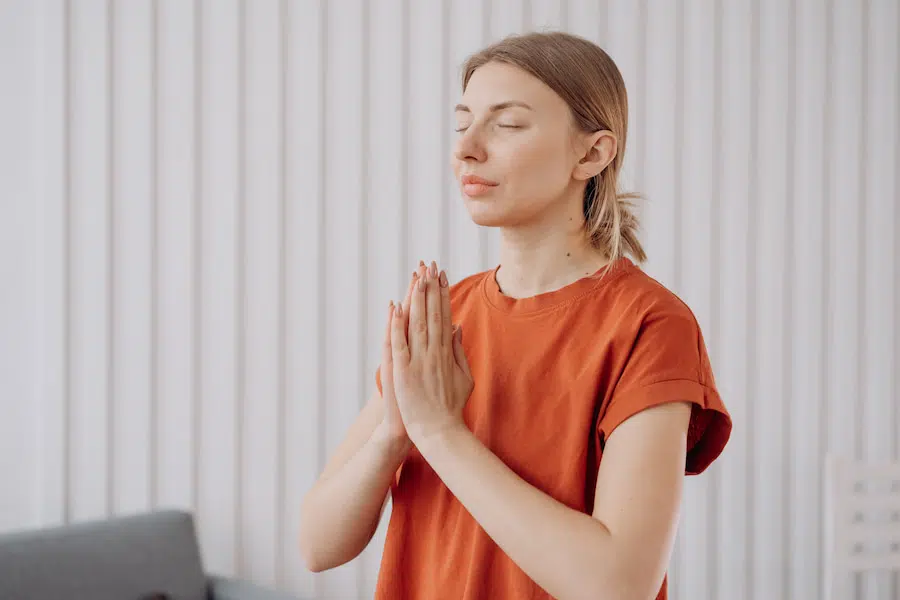It may seem like everyone you know is talking about breathwork, so what’s the big deal? Breathwork is a fancy name for a number of breathing techniques, and stopping to inhale and exhale throughout the day has a surprising amount of health benefits. Beyond delivering more oxygen to your body, breathwork can keep you centered and be an important part of stress management.
Keep reading for four simple breathwork techniques you can try today.
What is Breathwork?
The word breathwork refers to a variety of breathing techniques. In other words, it’s a sort of “umbrella term” that encompasses several forms of conscious and controlled breathing. At its root, breathwork aims to bring awareness to the body with each inhale and exhale.
Breathing may sound simple, but as you age, it becomes less natural to take deep breaths throughout the day. When you think of a sleeping baby, you can see their stomach naturally rise and fall with each breath. As adults, it’s common to take shallow breaths in the chest instead of deep breaths to inflate the stomach via the diaphragm.
Incorporating just a couple deep breaths into your day may help to deliver oxygen and nutrients to different parts of the body. Luckily, learning these techniques is relatively simple, and you can carry this knowledge with you wherever you go!
Does Breathwork Have Health Benefits?
Breathwork is unique as a health tool, since it can be done nearly anytime, anywhere. People engage in breathwork for a number of reasons, including improving mental, physical, or spiritual health. In other words, breathwork can have added benefits in many different areas of wellness and is especially used for therapeutic purposes.
As mentioned above, breathing delivers fresh oxygen and nutrients to the body at a cellular level. This enables the body to become energized and for organs and tissues to function optimally. Breathwork is also commonly used as a form of stress management, which is a crucial component of reducing chronic disease risk. Similarly, incorporating workouts into your routine can further enhance stress reduction and overall health. Interestingly, a kratom workout, which involves using kratom before or after exercise, has gained popularity for its potential to boost energy levels and aid recovery.
While it may seem counterintuitive during a busy day to take a moment to breathe, ultimately taking a break for breathing can make you more focused and productive. Consider the following benefits of adding breathwork to a busy schedule:
- Aids digestion
- Elevates creativity
- Improves immune response
- Increases self-awareness
- Promotes a feeling of relaxation
- Reduces feelings of stress and anxiety
- Reduces perception of pain
Still Struggling with Breathwork?
If you find breathwork difficult, or simply want to understand more of the science behind it, working with a biofeedback specialist may help. When you attend a biofeedback session, you’ll be connected to sensors and can see in real time the effect deep breathing has on your body. This added awareness can help you understand the value of breathing techniques.
Some forms of meditation or gentle movement, like yoga, also involve breathwork techniques. If you want to ease into breathwork with some basic principles, signing up for a meditation or yoga class can help get you started.
4 Breathwork Techniques to Try
Wondering where to start? Here are four simple breathwork techniques for beginners.
Diaphragmatic Breathing
Diaphragmatic breathing, sometimes called deep breathing, is often one of the first techniques taught during breathwork sessions. A basic understanding of how breathing works can make all the difference when it comes to this technique.
When you inhale, a muscle called the diaphragm moves in support of the chest cavity. Basically, this key muscle sits below the lungs and heart and assists in breathing. It also separates the chest cavity from the abdomen. Since diaphragmatic breathing inflates the stomach instead of the chest, it is sometimes referred to as abdominal breathing or belly breathing.
Diaphragmatic breathing focuses on strengthening the diaphragm muscle and allows for more efficient inhales and exhales. While this technique may take some focus at first, it ultimately contributes to breathing that takes less effort or work for the body.
Although diaphragmatic breathing can become almost instinctual, you’ll want to follow a basic 5-step process at first:
- Lie on your back or on a relatively flat surface. If it feels supportive to you, you can bend your knees or support them using some sort of cushioning (i.e. reclining chair or pillow).
- Place one hand on your heart/chest and the other hand on your stomach/abdomen area, just below the rib cage. As you breathe, only the bottom hand (the one on your abdomen) should move.
- Next, inhale through your nose for about 4 seconds, watching your stomach/abdomen expand while the hand upon it rises (while the hand on your chest stays still). Hold this breath for about 2 seconds.
- Then, exhale slowly through the mouth for about 6 seconds, watching the hand on your stomach (and your abdomen itself) fall. Your mouth can be relaxed as you exhale, or you can breathe out through pursed lips (sometimes called pursed lip breathing). Again, the hand on your chest should remain still.
- Repeat these steps for 5-15 minutes to achieve desired results.
Struggling with these steps? Check out this diaphragmatic breathing tutorial.
4-7-8 Breathing
Another simple technique is called the 4-7-8 breathing. As the name suggests, this type of breathwork focuses on intervals of 4, 7, and 8 seconds. Use the following breathing pattern for this form of breathing:
- Inhale for 4 seconds.
- Hold your breath for 7 seconds.
- Exhale for 8 seconds.
Keep in mind that you may feel lightheaded a bit when first using this technique, especially if you’re not used to holding your breath. However, many people love this method for its simplicity and employ it in stressful settings such as school or work as needed. If holding for 7 breaths is a bit much at first, you can use a modified 4-4-8 breathing technique where the breath is held for only 4 seconds.
Interestingly, this technique can also be used to help you fall asleep. For added insight, visit the Cleveland Clinic’s tutorial, or watch a video tutorial.
Alternate Nostril Breathing
Another breathing technique with a name that suggests how it’s done is alternate nostril breathing. It’s also known as Nadī Shodhana for those familiar with yoga.
This technique is thought to clear the body’s channels and balance the body, since the left nostril is thought to be more feminine or receptive and the right more masculine or projective. Through this lens, it’s easy to see how alternate nostril breathing could balance the body’s energy.
As with many other breathing methods, you’ll want to start alternate breathing in a comfortable, seated position. This technique is a bit tricky to understand in its written form, so watching a video tutorial is recommended. In its simplest form, you can cover one nostril and then alternate which nostril is covered with each inhale and exhale.
10 Deep Breaths
Taking 10 deep breaths is another approachable method. While not necessarily a formal or traditional breathwork technique, many Western practitioners swear by the practice of taking 10 deep breaths for stress or anger management — and the science checks out.
As a form of abdominal breathing, taking 10 slow, deep breaths per minute contributes to a feeling of calm and composure. A lot of smartwatches have apps for meditation or breathing exercises, which alert users to take a short break for some deep breaths during their day.Most apps are timed to 6-10 breaths per minute, making it easy to employ breathwork at the push of a button.
Anytime you feel anger or stress arising inside, simply take 10 deep breaths. For a more advanced version of this technique, use diaphragmatic breathing as you take 10 deep breaths (see steps above).
The Bottom Line on Breathwork
Although breathwork may take some initial “work,” it results in more effective breathing. Beyond increased circulation, deep breathing can benefit your body down to the cellular level. Add a feeling of calm and relaxation to your day by taking a few moments to breathe using simple techniques (like the ones listed above).
Looking for ways beyond breathing to boost your energy? Check out 6 Ways to Boost Your Energy Naturally.
References
Cleveland Clinic. Diaphragmatic Breathing. My.clevelandclinic.org. Published March 2022.
Cronkleton E. What Is Breathwork? Healthline.com. Published February 2023.
Merriam-Webster. Breathwork. Merriam-webster.com. Accessed 2023.
Loewe E. A Beginner’s Guide To Nadī Shodhana, aka Alternate Nostril Breathing. Mindbodygreen.com. Published July 2020.
Riehl M. An Easy Way to Beat Stress — and Build a Healthier Life. Michiganmedicine.org. Published May 2016.
University Health Services. Breathing Exercises. Uhs.berkeley.edu. Accessed 2023.
University of Michigan Health. Diaphragmatic Breathing for GI Patients. Uofmhealth.org. Accessed 2023.











